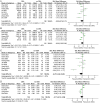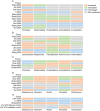Microbial dysbiosis in obstructive sleep apnea: a systematic review and meta-analysis
- PMID: 40444003
- PMCID: PMC12119640
- DOI: 10.3389/fmicb.2025.1572637
Microbial dysbiosis in obstructive sleep apnea: a systematic review and meta-analysis
Abstract
Background: The association between the microbiota and obstructive sleep apnea (OSA) remains understudied. In this study, we conducted a comprehensive systematic review and meta-analysis of studies investigating the diversity and relative abundance of microbiota in the gut, respiratory tracts and oral cavity of patients with OSA, aiming to provide an in-depth characterization of the microbial communities associated with OSA.
Methods: A comprehensive literature search across PubMed, the Cochrane Library, Web of Science, and Embase databases were conducted to include studies published prior to Dec 2024 that compared the gut, respiratory and oral microbiota between individuals with and without OSA. The findings regarding alpha-diversity, beta-diversity, and relative abundance of microbiota extracted from the included studies were summarized. This meta-analysis was conducted in accordance with the Preferred Reporting Items for Systematic Reviews and Meta-Analyses (PRISMA) guidelines, and the study protocol was registered with PROSPERO (CRD42024525114).
Results: We identified a total of 753 articles, out of which 27 studies were ultimately included in the systematic review, involving 1,381 patients with OSA and 692 non-OSA populations, including 1,215 OSA patients and 537 non-OSA populations in adults and 166 OSA patients and 155 non-OSA populations in children. The results of alpha diversity revealed a reduction in the Chao1 index (SMD = -0.40, 95% CI = -0.76 to -0.05), Observed species (SMD = -0.50, 95% CI = -0.89 to -0.12) and Shannon index (SMD = -0.27, 95% CI = -0.47 to -0.08) of the gut microbiota in patients with OSA. Beta diversity analysis indicated significant differences in the gut, respiratory and oral microbial community structure between individuals with OSA and those without in more than half of the included studies. Furthermore, in comparison to the non-OSA individuals, the gut environment of patients with OSA exhibited an increased relative abundance of phylum Firmicutes, along with elevated levels of genera Lachnospira; conversely, there was a decreased relative abundance of phylum Bacteroidetes and genus Ruminococcus and Faecalibacterium. Similarly, within the oral environment of OSA patients, there was an elevated relative abundance of phylum Actinobacteria and genera Neisseria, Rothia, and Actinomyces.
Conclusion: Patients with OSA exhibit reduced diversity, changes in bacterial abundance, and altered structure in the microbiota, especially in the gut microbiota. The results of this study provide basic evidence for further exploration of microbiome diagnostic markers and potential intervention strategies for OSA.
Keywords: gut microbiota; meta-analysis; obstructive sleep apnea; oral microbiota; respiratory tracts microbiota; systematic review.
Copyright © 2025 Guo, Sun, Wang, Chen, Kou, Yuan, Han and Yu.
Conflict of interest statement
The authors declare that the research was conducted in the absence of any commercial or financial relationships that could be construed as a potential conflict of interest.
Figures





References
-
- Bikov A., Szabo H., Piroska M., Kunos L., Szily M., Ligeti B., et al. . (2022). Gut microbiome in patients with obstructive sleep Apnoea. Appl. Sci. 12:12. doi: 10.3390/app12042007, PMID: - DOI
Publication types
LinkOut - more resources
Full Text Sources
Research Materials

